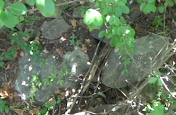Persimmon Sink is one of Austin’s lesser known sinkholes. This news article will explore and what Persimmon Sink is.
Located far away from the bustle of the city limits off FM 620 and Vista Parke Drive is a sinkhole called Persimmon Sink. Persimmon Sink is one of Austin’s lesser known sinkholes. Persimmon Sink is a sinkhole which is surrounded by oak trees, plateau live oak (Quercus fusiformis), cedar sedge (Carex planostachys), Texas persimmon fruit (Diospyros texana), and agarita (Mahonia trifoliolata). Texas persimmon fruit can be found growing around this sinkhole. Persimmon Sink was named after the Texas persimmon fruit and the Texas persimmon (Diospyros texana). (Ref: https://downloads.regulations.gov/FWS-R2-ES-2017-0018-0018/attachment_1.pdf)


Persimmon Sink is inadequate to sustain karst ecosystems. That is why there are not any insects. Of course Persimmon Sink is not known to contain federally listed species or karst features. The ecosystem of Persimmon Sink has been sparred from being destroyed or heavily impacted by ongoing construction and ongoing development. All of Persimmon Sink has been sparred from complete destruction. The larger karst features that are noticeable from the surface may be spared complete destruction, but the setbacks are inadequate to sustain karst ecosystems. (Ref: https://www.fws.gov/southwest/es/Documents/R2ES/draft%20GDF%20EAHCP%20for%20public%20comment.pdf)


Persimmon Sink is located off FM 620 and Vista Parke Drive, Austin, Texas, US 78726. 20 feet northeast of Little Sunshine's Playhouse and Preschool of Four Points.




No comments:
Post a Comment